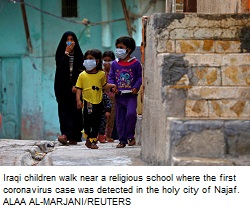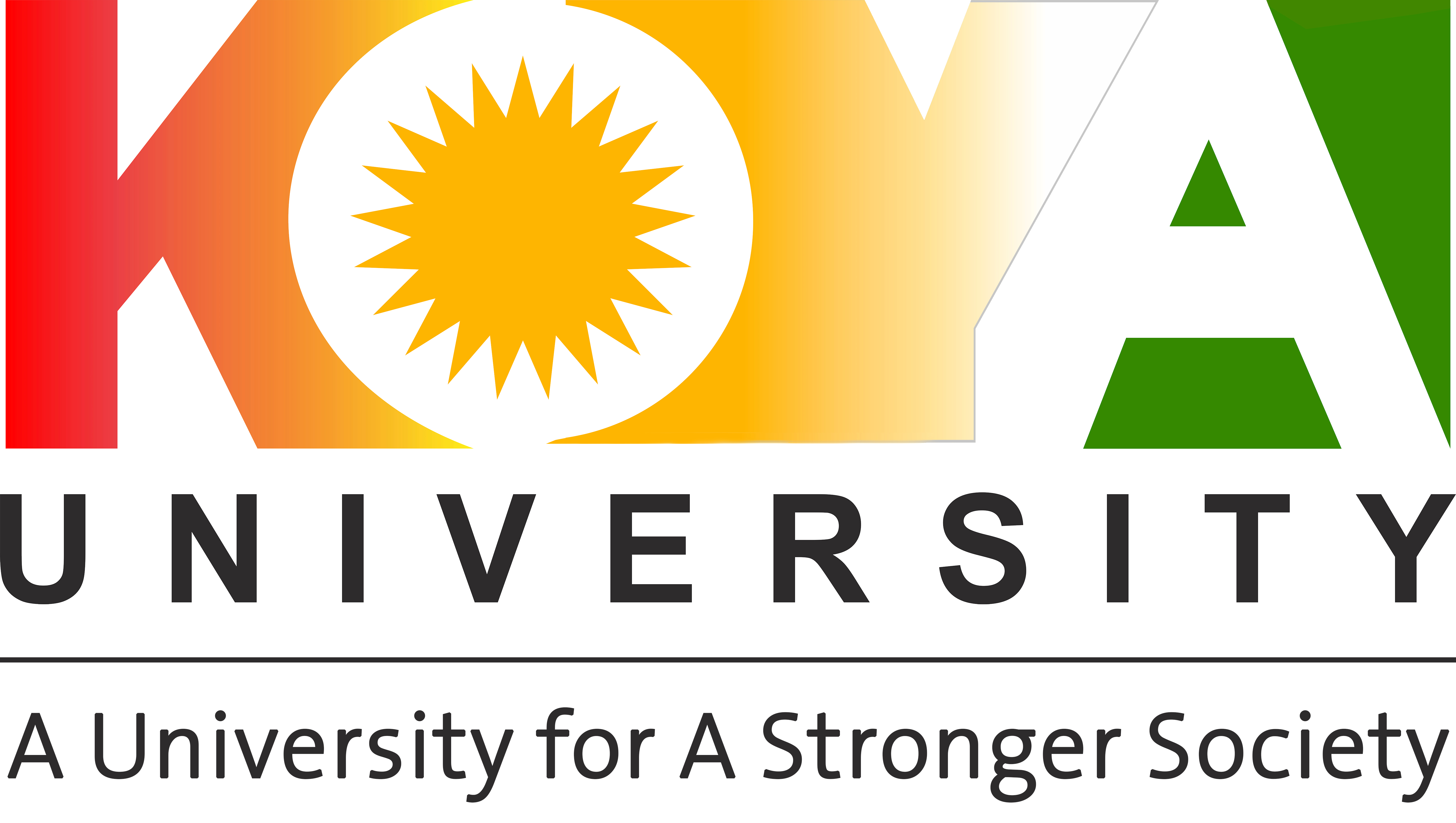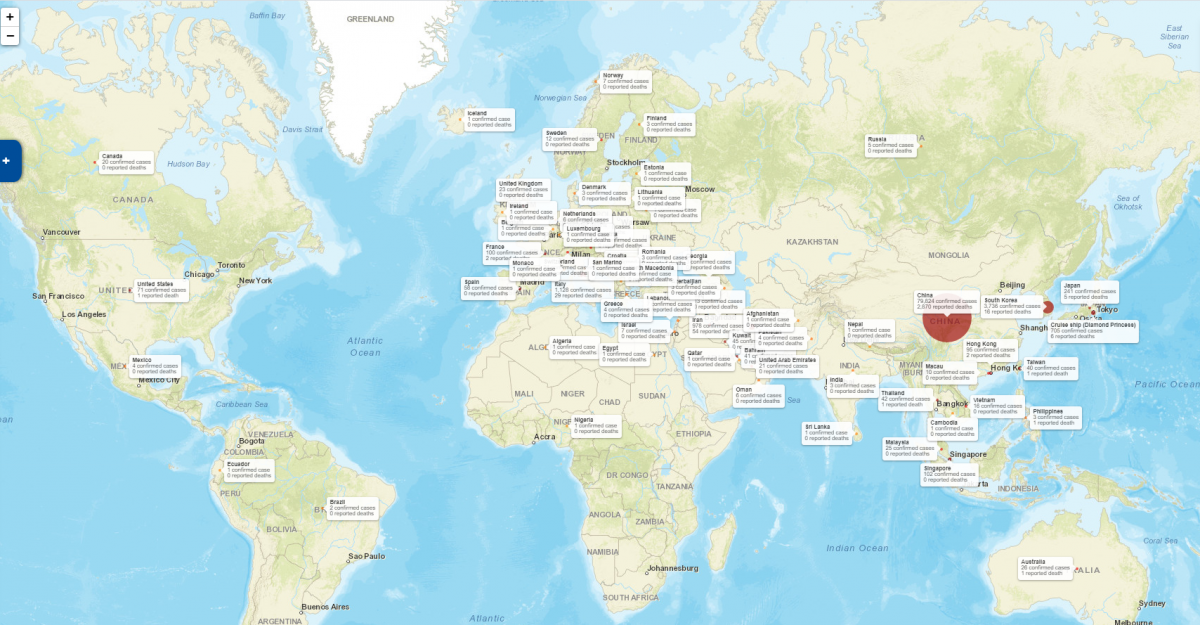Koya University is continously holding workshops and presenting seminars about the new serious threat to public health, which is coronavirus COVID-19. Please, read this essay:
Live Statistics (May 1st, 2020):
Coronavirus cases: 3,375,920
Death: 238,163
Recovered: 1,071,989
Countries and teritories affected by COVID-19: 212
Countries with recovered cases: 0
Iraq: Coronavirus cases: 2,153 | Deaths: 94
Iran: Coronavirus cases: 95,646 | Deaths: 6,091 ....
About Coronavirus:
A newly identified coronavirus SARS-CoV-2 (formerly 2019-nCoV) has been spreading in China, and has now reached multiple other countries. Here's what you need to know about the virus and the disease it causes, called COVID-19. The newly discovered coronavirus (2019-nCoV) genome has revealed differences between 2019-nCoV and severe acute respiratory syndrome (SARS) or SARS-like coronaviruses. A systematic comparison identified 380 amino acid substitutions between these coronaviruses, which may have caused functional and pathogenic divergence of 2019-nCoV.
Symptoms:
- Fever
- Cough
- Shortness of breath
Incubation Period:
A Chinese study published in the New England Journal of Medicine on Jan. 30, has found the incubation period to be 5.2 days on average, but it varies greatly among patients. The Chinese team conducting the study said their findings support a 14-day medical observation period for people exposed to the pathogen.
How COVID-19 Spreads?
Current understanding about how the virus that causes coronavirus disease 2019 (COVID-19) spreads is largely based on what is known about similar coronaviruses.
- Person-to-person spread .
- Spread from contact with infected surfaces or objects.
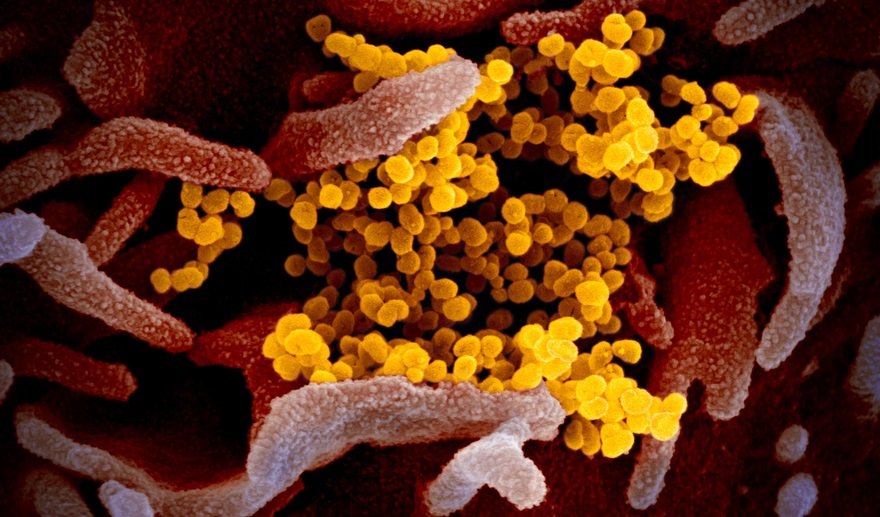
A scanning electron microscope image from the NIH's National Institute of Allergy and Infectious Diseases shows SARS-CoV-2 in yellow, also known as the novel coronavirus. (Image: NIAID - Rocky Mountain Laboratories)
Prevention:
- Avoid close contact with people who are sick.
- Avoid touching your eyes, nose, and mouth.
- Stay home when you are sick.
- Cover your cough or sneeze with a tissue, then throw the tissue in the trash.
- Clean and disinfect frequently touched objects and surfaces using a regular household cleaning spray or wipe.
- Facemasks should be used by people who show symptoms of COVID-19 to help prevent the spread of the disease to others. The use of facemasks is also crucial for health workers and people who are taking care of someone in close settings (at home or in a healthcare facility).
- Wash your hands often with soap and water for at least 20 seconds, especially after going to the bathroom; before eating; and after blowing your nose, coughing, or sneezing.
- If soap and water are not readily available, use an alcohol-based hand sanitizer with at least 60% alcohol. Always wash hands with soap and water if your hands are visibly dirty.
Diagnosis
Since there is no effective treatment for coronavirus infections, establishing the diagnosis is of limited utility in patients suspected of having community-acquired coronavirus infections. In contrast, diagnosing coronavirus disease 2019 (COVID-19), Middle East respiratory syndrome coronavirus (MERS-CoV), and severe acute respiratory syndrome coronavirus (SARS-CoV) is critically important for understanding outbreak epidemiology and limiting transmission of infection. Until recently, no sensitive, rapid method existed to detect all of the known human coronavirus strains. Rapid techniques that can be used to detect coronaviruses from nasopharyngeal samples include reverse-transcriptase polymerase chain reaction (RT-PCR) and immunofluorescence antigen detection assays.
Vaccintion:
US biotech firm Moderna has shipped an experimental coronavirus vaccine to US government researchers just six weeks after it started working on the immunization.
Initial trials of the potential vaccine could begin in April, but the process of testing and approvals would last at least a year.
Treatment:
The President of the United States, Donald Trump, announced on 19 March that chloroquine (hydroxychloroquine/Plaquenil), a drug used to treat malaria and arthritis, was approved by the US Food and Drug Administration (FDA) to be tested as a treatment for COVID-19. Chloroquine is being tested in various clinical trials conducted by government agencies and academic institutions.
Important notes:
- 80.9% of infections are mild (with flu-like symptoms) and can recover at home.
- 13.8% are severe, developing severe diseases including pneumonia and shortness of breath.
- 4.7% as critical and can include: respiratory failure, septic shock, and multi-organ failure.
- probability of dying if infected by the virus (%) is 14.8% for 80+ years old and only 0.2% for 10-19 years old.
- No fatilities are recordedfor 0-9 years old.
- Death rate for infected males are almost double the rate for the infected females.
 Figure: First case of 2019 novel coronavirus in Canada
Figure: First case of 2019 novel coronavirus in Canada
Chest x-ray shows bilateral peribronchovascular, ill-defined opacities in all lung zones
DOI:https://doi.org/10.1016/S0140-6736(20)30370-6
Will warming spring temperatures slow the coronavirus outbreak?
Viruses that cause influenza or milder coronavirus colds do tend to subside in warmer months because these types of viruses have what scientists refer to as “seasonality,” so the president’s comments have some scientific backing. But it’s highly uncertain that SARS-CoV-2 will behave the same way. Those currently studying the disease say their research is too early to predict how the virus will respond to changing weather.
How coronavirus compares to flu, Ebola, and other major outbreaks?
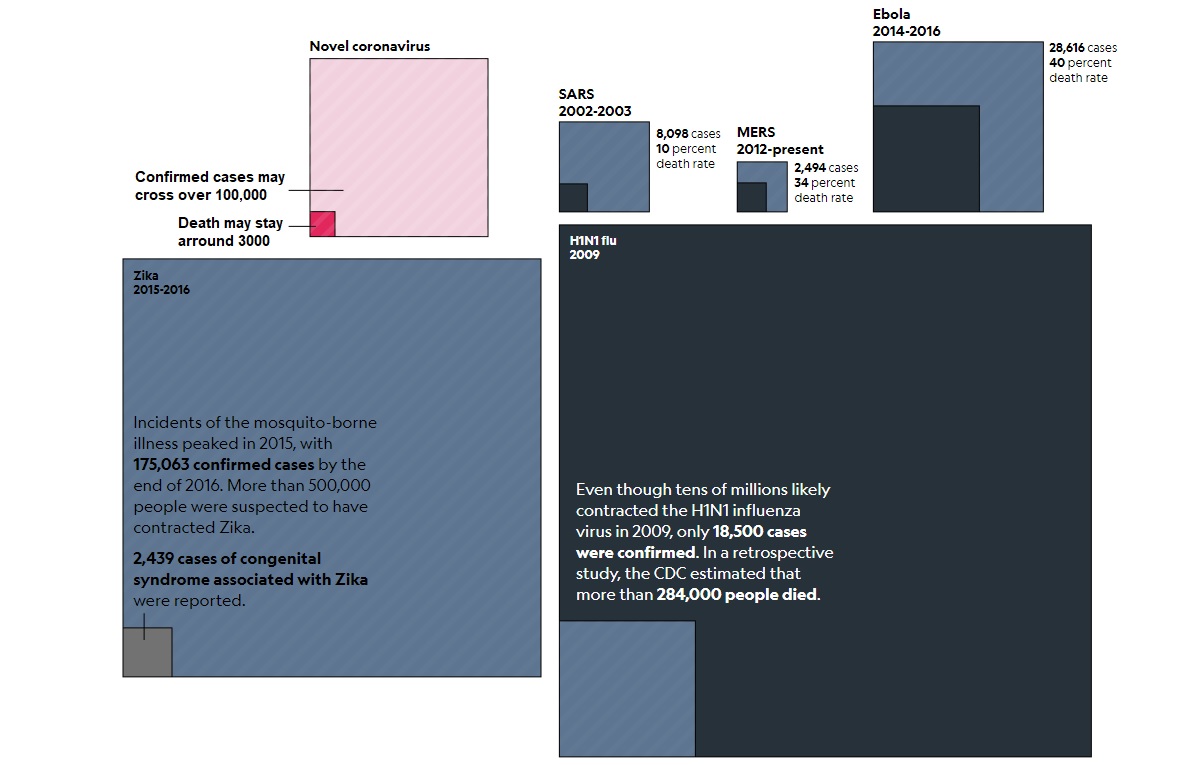
Updated image: National Geography,
https://www.nationalgeographic.com/science/2020/02/graphic-coronavirus-…
References:
- https://www.worldometers.info/coronavirus/
- https://www.livescience.com/new-china-coronavirus-faq.html
- Center of Disease Control and prevention: https://www.cdc.gov/coronavirus/2019-ncov/index.html
- World Health Organization: https://www.who.int/emergencies/diseases/novel-coronavirus-2019
- CNN Business: https://edition.cnn.com/
- UpToDate, Coronavirus. https://www.uptodate.com/contents/coronaviruses
- National Geography, https://www.nationalgeographic.com/science/2020/02/graphic-coronavirus-…
- FierceBiotech, https://www.fiercebiotech.com/medtech/coronavirus-tests-public-health-i…
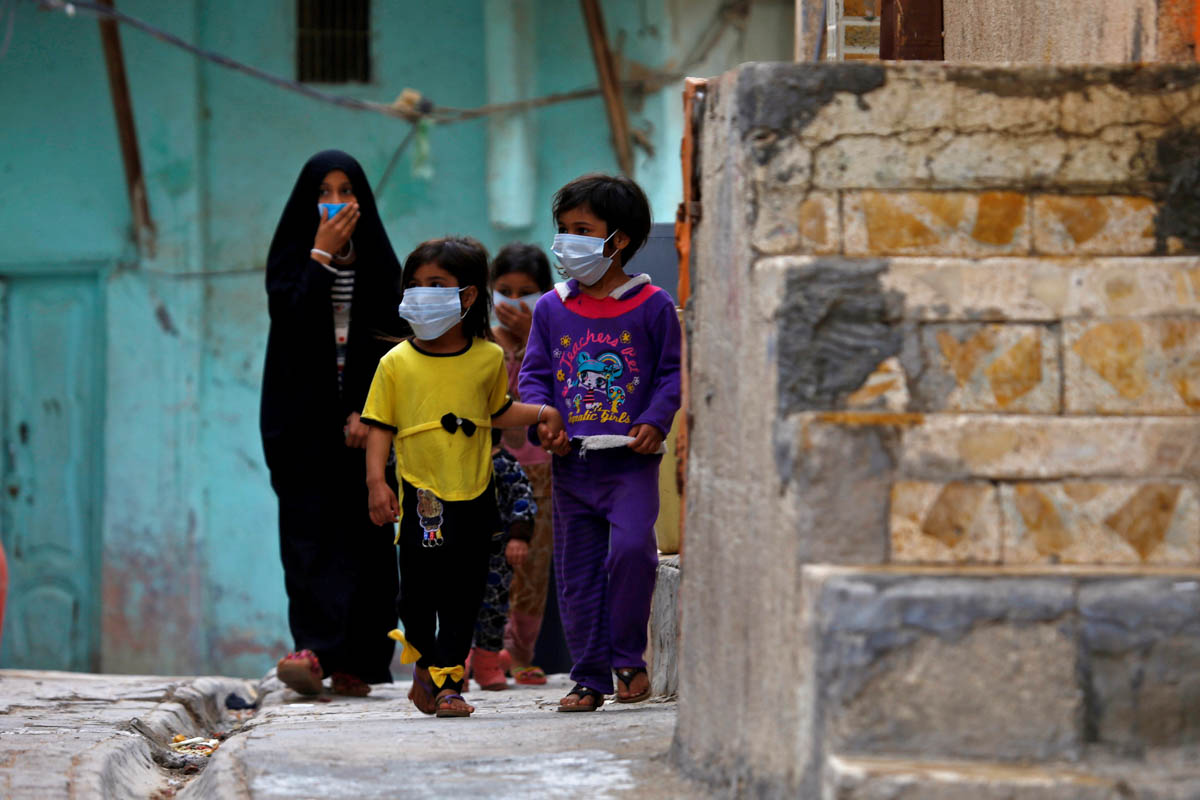
Iraqi children walk near a religious school where the first coronavirus case was detected in the holy city of Najaf.
ALAA AL-MARJANI/REUTERS
Latest Research Articles:
Radiological findings from 81 patients with COVID-19 pneumonia in Wuhan, China: a descriptive study
Heshui Shi, Xiaoyu Han, Nanchuan Jiang, Yukun Cao, Osamah Alwalid, Jin Gu, Yanqing Fan, Chuansheng Zheng
The Lancet Infectious Diseases
Published: February 24, 2020
Full-Text HTML | PDF
Clinical course and outcomes of critically ill patients with SARS-CoV-2 pneumonia in Wuhan, China: a single-centered, retrospective, observational study
Xiaobo Yang, Yuan Yu, Jiqian Xu, Huaqing Shu, Jia'an Xia, Hong Liu, Yongran Wu, Lu Zhang, Zhui Yu, Minghao Fang, Ting Yu, Yaxin Wang, Shangwen Pan, Xiaojing Zou, Shiying Yuan, You Shang
The Lancet Respiratory Medicine
Published: February 24, 2020
Full-Text HTML | PDF
Early epidemiological analysis of the coronavirus disease 2019 outbreak based on crowdsourced data: a population-level observational study
Kaiyuan Sun, Jenny Chen, Cécile Viboud
The Lancet Digital Health
Published: February 20, 2020
Open Access
Full-Text HTML | PDF
Preparedness and vulnerability of African countries against importations of COVID-19: a modelling study
Marius Gilbert, Giulia Pullano, Francesco Pinotti, Eugenio Valdano, Chiara Poletto, Pierre-Yves Boëlle, Eric D'Ortenzio, Yazdan Yazdanpanah, Serge Paul Eholie, Mathias Altmann, Bernardo Gutierrez, Moritz U G Kraemer, Vittoria Colizza
The Lancet
Published: February 20, 2020
Full-Text HTML | PDF
Clinical characteristics and intrauterine vertical transmission potential of COVID-19 infection in nine pregnant women: a retrospective review of medical records
Huijun Chen, Juanjuan Guo, Chen Wang, Fan Luo, Xuechen Yu, Wei Zhang, Jiafu Li, Dongchi Zhao, Dan Xu, Qing Gong, Jing Liao, Huixia Yang, Wei Hou, Yuanzhen Zhang
The Lancet
Published: February 12, 2020
Full-Text HTML | PDF
Nowcasting and forecasting the potential domestic and international spread of the 2019-nCoV outbreak originating in Wuhan, China: a modelling study
Joseph T Wu, Kathy Leung, Gabriel M Leung
The LancetPublished: January 31, 2020
Full-Text HTML | PDF
Genomic characterisation and epidemiology of 2019 novel coronavirus: implications for virus origins and receptor binding
Roujian Lu, Xiang Zhao, Juan Li, Peihua Niu, Bo Yang, Honglong Wu, Wenling Wang, Hao Song, Baoying Huang, Na Zhu, Yuhai Bi, Xuejun Ma, Faxian Zhan, Liang Wang, Tao Hu, Hong Zhou, Zhenhong Hu, Weimin Zhou, Li Zhao, Jing Chen, Yao Meng, Ji Wang, Yang Lin, Jianying Yuan, Zhihao Xie, Jinmin Ma, William J Liu, Dayan Wang, Wenbo Xu, Edward C Holmes, George F Gao, Guizhen Wu, Weijun Chen, Weifeng Shi, Wenjie Tan
The Lancet, Vol. 395, No. 10224, p565–574
Published: January 30, 2020
Full-Text HTML | PDF
Epidemiological and clinical characteristics of 99 cases of 2019 novel coronavirus pneumonia in Wuhan, China: a descriptive study
Nanshan Chen, Min Zhou, Xuan Dong, Jieming Qu, Fengyun Gong, Yang Han, Yang Qiu, Jingli Wang, Ying Liu, Yuan Wei, Jia'an Xia, Ting Yu, Xinxin Zhang, Li Zhang
The Lancet, Vol. 395, No. 10223, p507–513
Published: January 30, 2020
Full-Text HTML | PDF
Clinical features of patients infected with 2019 novel coronavirus in Wuhan, China
Chaolin Huang, Yeming Wang, Xingwang Li, Lili Ren, Jianping Zhao, Yi Hu, Li Zhang, Guohui Fan, Jiuyang Xu, Xiaoying Gu, Zhenshun Cheng, Ting Yu, Jiaan Xia, Yuan Wei, Wenjuan Wu, Xuelei Xie, Wen Yin, Hui Li, Min Liu, Yan Xiao, Hong Gao, Li Guo, Jungang Xie, Guangfa Wang, Rongmeng Jiang, Zhancheng Gao, Qi Jin, Jianwei Wang, Bin Cao
The Lancet, Vol. 395, No. 10223, p497–506
Published: January 24, 2020
Full-Text HTML | PDF
A familial cluster of pneumonia associated with the 2019 novel coronavirus indicating person-to-person transmission: a study of a family cluster
Jasper Fuk-Woo Chan, Shuofeng Yuan, Kin-Hang Kok, Kelvin Kai-Wang To, Hin Chu, Jin Yang, Fanfan Xing, Jieling Liu, Cyril Chik-Yan Yip, Rosana Wing-Shan Poon, Hoi-Wah Tsoi, Simon Kam-Fai Lo, Kwok-Hung Chan, Vincent Kwok-Man Poon, Wan-Mui Chan, Jonathan Daniel Ip, Jian-Piao Cai, Vincent Chi-Chung Cheng, Honglin Chen, Christopher Kim-Ming Hui, Kwok-Yung Yuen
The Lancet, Vol. 395, No. 10223, p514–523
Published: January 24, 2020
Full-Text HTML | PDF
Pathological findings of COVID-19 associated with acute respiratory distress syndrome
Zhe Xu, Lei Shi, Yijin Wang, Jiyuan Zhang, Lei Huang, Chao Zhang, Shuhong Liu, Peng Zhao, Hongxia Liu, Li Zhu, Yanhong Tai, Changqing Bai, Tingting Gao, Jinwen Song, Peng Xia, Jinghui Dong, Jingmin Zhao, Fu-Sheng Wang
The Lancet Respiratory Medicine
Published: February 18, 2020
Full-Text HTML | PDF
Novel Coronavirus Map .... Click on to see
Edited by: Prof. Salah I. Yahya
[email protected]
----------
Koya University (KOU) is located in the city of Koya (Koy Sanjaq) which is 1.0 hr drive to the East of the Kurdistan Region capital Erbil (Arbil, Hewlér) in Kurdistan Region of F.R. Iraq. It is on the foothills of beautiful high mountain. Its campus has been carefully laid out to embrace the beautiful mountainous nature. . There are 4 Faculties and 2 Schools in KOU; Faculty of Engineering (FENG), Faculty of Science and Health (FSCH), Faculty of Education (FEDU), Faculty of Humanities and Social Silences (FHSS), Shcool of Physical Education (SPHE) and School of Medicine (SMED). Also, there are two research centers; Genome Center and Malai Gawra Center. Moreover, at KOU there is an English Language Center (BELC) at KOU has been opened with the sponsorship of IREX and American embassy in Baghdad as well as with the support of Spring International Language Center of The University of Arkansas. KOU has two Scientific Journals; ARO-The Scientific Journal of Koya University, which is indexed by Clarivate Analytics (ESCI), and Koya University Journal of Humanities and Social Sciences (KUJHSS). KOU is a proactive member of Erasmus/ Marhaba Project and Erasmus+. KOU signed many Memorandum of Understandings (MoU) with many International Universities, e.g., The University of Arkansas (June 2015). The Lulea University in Sweden (April 2014), The University of Nottingham in the UK, The University of Buckingham in the UK (Oct 2008), Belkin University in Turkey (Sep 2009) and The University of Greenwich in the UK.
